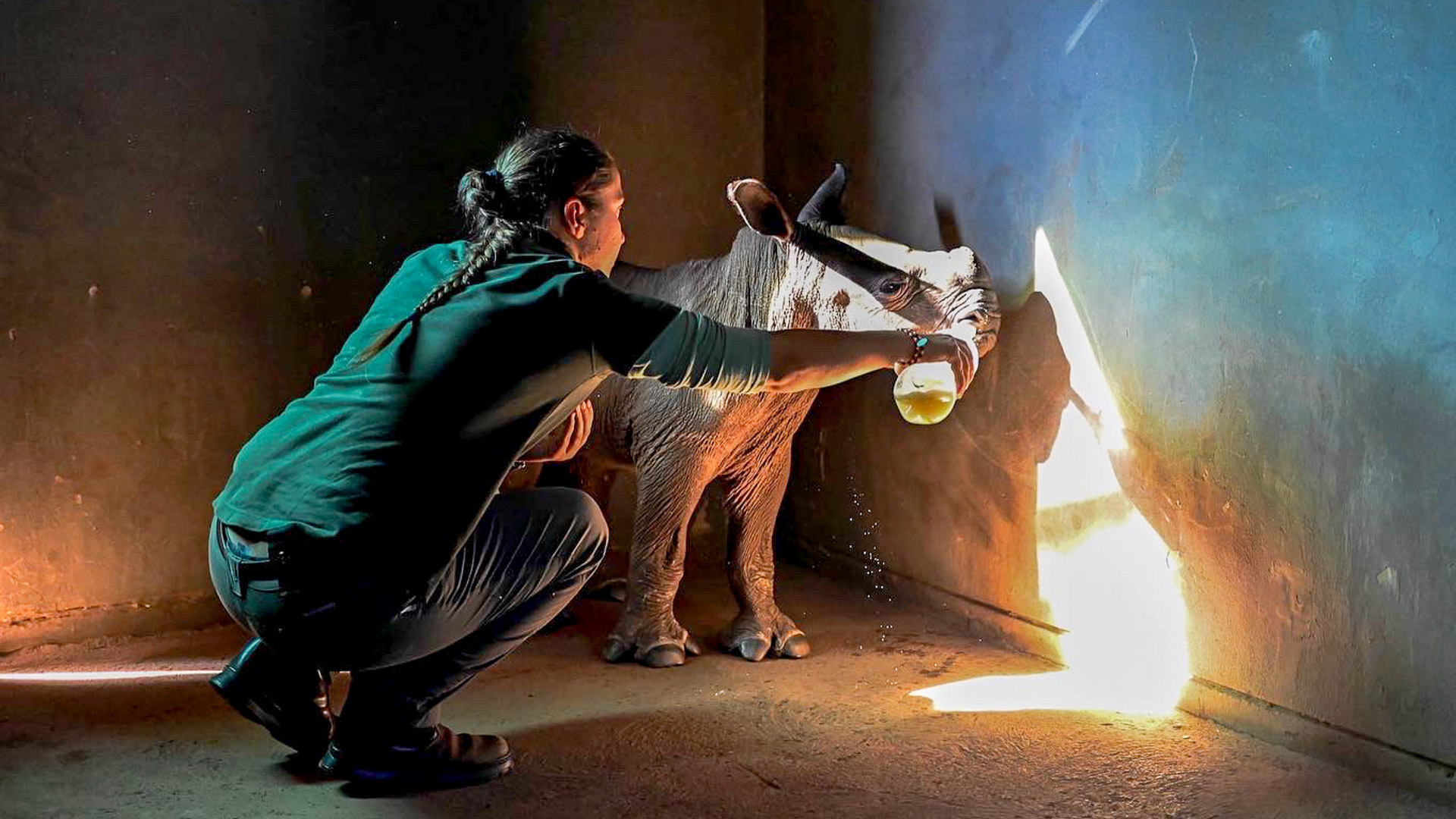
The blades of the helicopter thumped in over the treetops. They were carrying hope. In the back of the four-seat chopper, an orphaned rhino calf was destined for a new home. Within seconds of touching down in the swaying, South African grass, the calf was carried into the back of a waiting SUV and ferried down dirt roads en route to an intensive care unit at the world’s first orphanage for rhinos.

Inside, a team of trained veterinarians and dedicated conservation volunteers worked feverishly to keep the baby rhino alive. He’d been found without his mother and aided by local farmers before the teams from The Rhino Orphanage and veterinarian nonprofit Saving the Survivors coordinated to bring the weeks-old calf to a refuge specifically designed to save his life.
“The experience is very unique and life-changing,” says conservationist and environmental content creator Margarita Samsonova, who was on-site that day. “You are being educated on these topics and you feel like you can actually make a difference.”
Once thought to be completely extinct in the wild, numbers of white rhino have rebounded in South Africa since a low of less than 100 around 1900. Conservation groups are keeping the near-threatened species a step away from the endangered species list. Approximately 18,000 individuals exist in the wild — enough to fill most NBA basketball arenas in America — but only 5,600 of their cousins, the critically endangered black rhino, remain.
Since 2012, the people at The Rhino Orphanage have cared for both species, shedding both tears of sorrow and tears of joy in that journey. They’re part of a growing number of conservation projects around the globe that the general public can participate in, either through long-term or short-term volunteering.

Volunteering Vs. Voluntourism Experiences
Fueled by a rise in global travelers seeking experiences, conservation organizations around the planet have tapped into voluntourism as a way to generate funding for wildlife protection and research. Samsonova says she began working with wildlife conservation projects more than a decade ago. In that time, she has visited projects from Africa to Alaska. Though she holds a degree in zoology and animal biology, the voluntourism work she’s documenting at The Rhino Orphanage requires no formal education to participate in.
Anyone can join the crew. However, there are some key differences between voluntourism experiences and traditional volunteering.
“A voluntourism experience can be done for a short time period,” says Samsonova. “It gets people excited about being with wildlife and enhances their travel experience. It makes unforgettable memories. It’s also a way to generate money for conservation work in places where the governments are not funding it.”
Samsonova says actual volunteering is done long term and benefits conservation groups in different ways. Usually, a three-month to six-month minimum is required for volunteers — long enough to become a more independent part of a conservation project. “You come up with your own tasks and learn to figure out where your help is needed so that you are not taking away time from the people that actually work there. After a while, they are not generally guiding you.”
For travelers who want to work with wildlife in a short time frame, voluntourism offers a great path to fulfilling that goal. However, there are some red flags to be aware of when searching for the right fit.

Red Flags In Voluntourism
Voluntourism has become a $3 billion global industry reaching far beyond wildlife conservation. Education, disaster relief and other social projects also fall under its scope. And, as with any paper trail, Samsonova says there are bad actors in the industry. That means people interested in traveling to participate in conservation projects should look out for some key red flags.
- Are volunteers as hands-off as possible with animals? Wild animals do not generally benefit from building close relationships with humans. Look for groups that limit voluntourist one-on-one interaction with animals.
- Is the project guaranteeing exposure to animals? Legitimate short-term voluntourism opportunities rarely guarantee any kind of animal experience. Instead, look for groups that focus on the work you will be doing to help actual staff and volunteers.
- Is the organization conducting actual research? Projects that exist for the sole benefit of tourists are an immediate red flag.
“The first project I did, I would not recommend to anyone,” adds Samsonova. “It was in Thailand, and it was using and abusing animals for tourists to take pictures with them. I was there a month before I put the puzzle pieces together. Unfortunately, if you don’t do the research beforehand, you can end up in places like that.”

How To Get Involved
Samsonova recommends African Conservation Experiences for travelers interested in ethical voluntourism in southern Africa. In addition to white and black rhinos, African Conservation Experiences also works with big cats like lions, cheetahs and leopards, as well as other mammals and birds.
In the United States, the American Shark Conservancy — a Florida-based nonprofit dedicated to the conservation of sharks and rays — has partnered with dive operators throughout the Sunshine State to bring conservation science on shark dives. Conservation experiences turn divers into citizen scientists who use a laser and camera rig to take measurements and ID photos of sharks spotted on dives.
“With the high pressure of fishing, increased habitat loss and climate change combined with their slow reproduction rates, some shark species have declined by more than 90%,” says conservationist Cassandra Scott. “Shark conservation, done right, gives us a chance to help restore these delicately balanced ecosystems.”
The ASC recommends Shark Safari as a starting point for divers interested in helping with shark conservation. Though none of the 43 species of Atlantic shark managed by NOAA are listed as endangered, the divers also work to document the endangered sawfish — one of the most endangered groups of marine fish on the planet.

“Observing all of these firsthand really made me want to do more for them, and I hope it does the same for others,” says Scott. “To be able to get out of your comfort zone and truly connect in their world is a surreal encounter, but knowing you’re collecting data and contributing to shark research that can help create policies for conservation is really a monumental experience.”
Global volunteerism organizations like Projects Abroad and Go Eco offer portals to wildlife tourism around the world. Research each project for red flags extensively before deciding to commit.
Important conservation projects don’t have to be located far from home. Samsonova recommends people seek out local organizations doing conservation work in their area. “They may not sound as exciting as working with rhinos. but the difference you would be making in your local area — studying plants or frogs, for example — is as huge as researching rhino populations in southern Africa.”
Currently, more than 7,000 species are listed as endangered around the planet. And you don’t have to take time off work to get involved. Even posting on social media and having open dialogue can make a difference.





